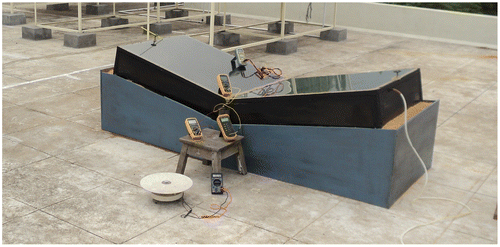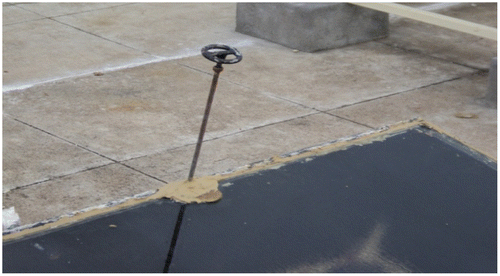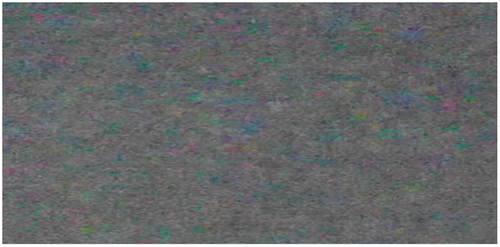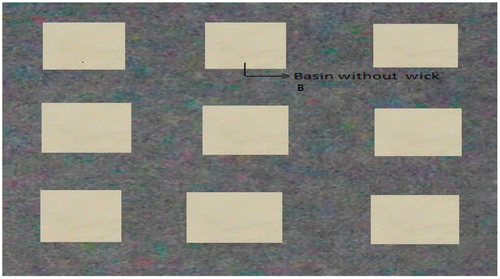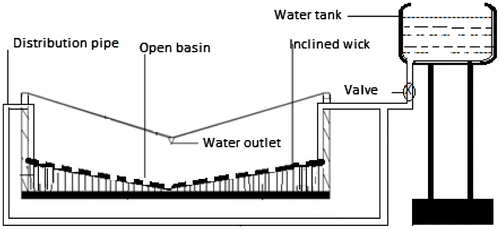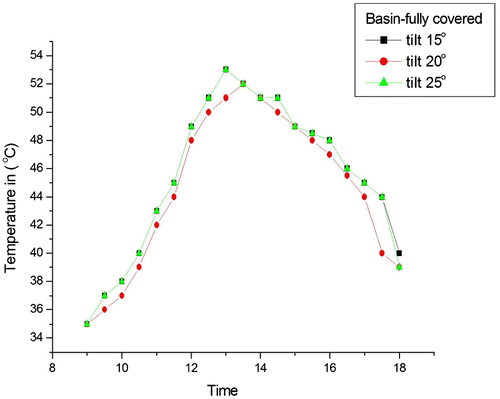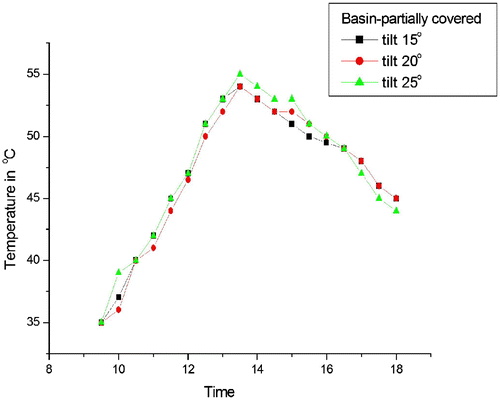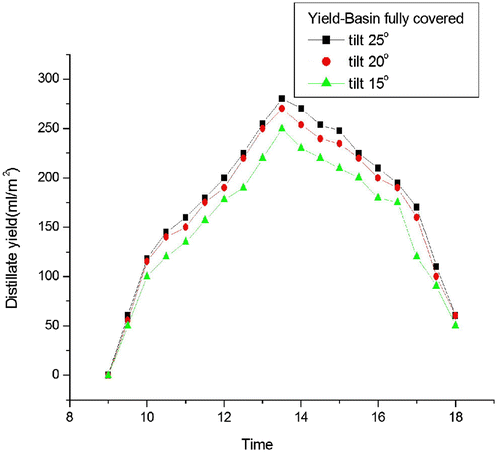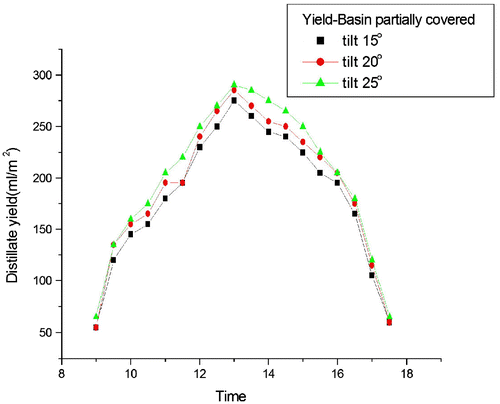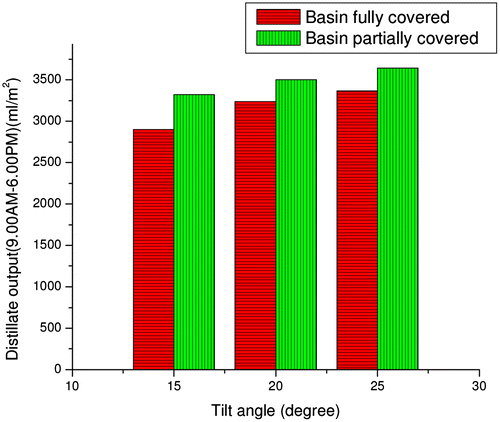Abstract
Solar distillation has yet to achieve widespread acceptance due to various technical difficulties and maintenance requirements which might not be acceptable or feasible for local communities. Emphasis has now shifted on the assimilation of locally available materials and expertise for optimum output. Coimbatore and nearby areas in South India have cotton waste material because the textile industry has flourished over the past ten years. A new design of wick and the performance of the solar still are parametrically analyzed in this paper. A “V”-type solar still of 1.5 m2 was constructed for experimental verification and data collection. The glass temperature, ambient air temperature and solar radiation were recorded during the sunny days. The effect of the tilt angle in the Coimbatore climatic conditions is also presented in this paper. The system was tested in two ways: (1) tilt basin fully covered by wick and, (2) tilt basin partially covered by the wick. Since the partial coverage of the wick yielded higher output and would be lower cost, this is the superior arrangement. The optimum tilt of the wick was found to be 25°. The system with tilt basin fully covered by wick produced distillate yield of 3,365 ml (m2-day) whereas the system with tilt basin partially covered by wick produced distillate yield of 3,640 ml (m2-day).
Public interest statement
A solar still converts salt/brackish water into potable water using solar radiation. The basin heats up and water in the basin/absorber evaporates and condenses on the glass cover. The temperature difference between the evaporating surface and condensing surface plays an important role in how much pure water is produced. An attempt has been made to study the performance of a “V”-type still that has two basins that can be tilted. Instead of a pool of salty water, the basins use a wick to evaporate water. An external water tank flows water over the wick. The basic design tested was a wick covering the entire bottom of the stills. However, a wick with holes in it produced more drinkable water. And it actually costs less! This should help bring sustainable drinking water to more remote places.
1. Introduction
Solar distillation is a natural phenomenon on earth. Solar energy heats water in the seas and lakes, evaporates it, and condenses it as clouds to return to earth as rain water. Basin-type solar still systems replicate this natural phenomenon on a small scale. Solar distillation still holds the key to several activities in water deficient areas including semi arid and arid areas. The technology has matured over the years and efficiency has been improved. Specific applications need changes in conventional designs to optimize economic performance.
Design and technological innovations are needed now in this field. In a basin- type solar wick still, the feed water is absorbed slowly by the porous radiation-absorbing pad (the wick). Two advantages are claimed over basin stills. First, the wick can be tilted, so that the feed water presents a more suitable angle to the sun (reducing reflection and presenting a large effective area). Second, less feed water is in the still at any time, and thus the water is heated more quickly and to a higher temperature. Some papers by many authors have demonstrated wick systems’ performance and cost effectiveness (Aybar, Egelioğlu, & Atikol, Citation2005; Janarthanan, Chandrasekaran, & Kumar, Citation2006; Kalidasa Murugavel & Srithar, Citation2011; Malaiyappan & Elumalai, Citation2016; Minasian & Al-Karaghouli, Citation1995). Performance of an inclined type solar still with different wick materials on different absorber plate configurations was studied by Hansen, Narayanan, and Murugavel (Citation2015). Based on the analysis they found that water coral fleece material is the most productive wick material. Maximum distillate achieved in the still was 4.28 l/day by using water coral fleece with a weir mesh-stepped absorber plate. Omara, Kabeel, Abdullah, and Essa (Citation2016) conducted experiments with corrugated wick and reflectors. The still was tested with using a double layer wick material. Performance of a corrugated solar still and conventional solar still were investigated and found that productivity of a solar still with a wick was higher than the conventional solar still at a brine depth of 1 cm. An experimental investigation on the performance of solar still augmented with a pin-finned wick evaporation surface was reported by Alaian, Elnegiry, and Hamed (Citation2016). The fins were supported vertically on the basin of the still using steel wires. Enhancing the still productivity was proved when the pin-finned wick was applied in the still. Akash, Mohsen, Osta, and Elayan (Citation1998) have studied the effect of using different absorbing materials in a single basin solar still to enhance the productivity of water. Experimental results showed that the productivity of distilled water was enhanced by 38% for black rubber mat absorber, 45% for black ink and 60% for black dye absorber. Srivastava and Agrawal (Citation2013) studied the thermal performance of single sloped basin type solar still consisting of multiple low thermal inertia floating porous absorbers. Multiple floating absorbers of smaller width ensured that the absorber surface was always wet due to capillary action and there were no dry spots. They concluded that due to low thermal inertias of the porous absorber 68% more distillate output was obtained. Mahdi, Smith, and Sharif (Citation2011) conducted experiments with a tilted wick. The charcoal cloth was used as an absorber/evaporator material and for saline water transport. It has been concluded that the charcoal cloth is a good material for use as an absorber/evaporator and also as a water transport medium. Suneesh, Paul, Jayaprakash, Kumar, and Denkenberger (Citation2016) conducted experiments using an inclined wick and cotton gauze cooling over condensing glass cover with regenerative effect. A 20 W suction pump was used for hot water circulation. The system with cotton gauze produced distillate yield of 6,300 ml/m2 whereas the system without cotton gauze produced distillate yield of 5,600 ml/m2. The effect of a solar chimney used to enhance the convective currents within a solar still was studied by Refalo, Ghirlando, and Abela (Citation2016). In the configuration analyzed, water vapour was passed through a number of ducts immersed in seawater. This solar still was constructed and tested under natural weather conditions using a typical simple solar still as a benchmark. When comparing the efficiency based on the actual evaporator (basin) area, they noted that the solar still with the solar chimney and condensers performed 8.8% better. Ayoub, Al-Hindi, and Malaeb (Citation2015) describes a modification of a solar still that significantly enhances its productivity without forsaking its basic features. A simple amendment in the form of a slowly rotating drum is introduced allowing the formation of thin water films that evaporate rapidly and are continually renewed. The performance of this system was compared against a control without the introduced drum. Throughout the experiment, the new system gave considerably higher yield than the control with an average increase in daily productivity of 200%. A theoretical analysis of a tilted wick solar still with a flat plate bottom reflector extending from the lower edge of the still was discussed by Tanaka (Citation2013). An increase in the daily amount of distillate produced by the still in comparison to a conventional tilted wick solar still averaged about 21, 28 and 33% throughout the year by using a flat plate bottom reflector, and adjusting the inclination of both the still and the reflector to a proper angle for each month when the ratio of the reflector length to still length is 0.5, 1.0 and 2.0, respectively.
In this paper, the objective to do conduct a performance analysis of wick tilt and wick coverage is studied experimentally. A modified wick design was proposed and the improved performance experimentally validated. The experiment was conducted for different basin tilt angles (15°, 20° and 25°) and the optimum tilt was found. An external water tank was connected to the still via a valve. The valve was adjusted for different flow rates so that the wick was always wet and no dry spots were formed, and to minimize excess flow. Therefore the flow rate was adjusted every 30 min depending upon the distillate output and the other parameters as mentioned above. Water spreads over the wick surface by capillary action and flows under gravity to the lower side, and excess flow is removed by an outlet pipe. The glass temperature, ambient air temperature and solar radiation were recorded during the sunny days.
2. Fabrication details
Photographs and schematic representation of solar still, wick and experimental set up are presented in Figures –. Length and breadth of the still sections are 1.00 and 0.75 m respectively for a total area of 1.5 m2. Bottom and sides of the still were painted black for good absorption of solar radiation. Proper insulation has been provided by a wooden case with the gap filled with saw dust to prevent heat loss. An inward inclination of 18o was provided for the glass, the centre and sides of the glass pasted by chemical adhesive to prevent air leakage. Calibrated Cu-Constantan thermocouples were used to measure the temperature. The temperatures of air, glass covers, wick and absorber, the solar radiation (W/m2) and the distillate output were recorded at regular intervals of time.
Figure 6. (a) Variation of glass temperature during experimental study for different tilt angles (basin fully covered by wick) as a function of day hour and (b) Variation of glass temperature during experimental study for different tilt angles (basin partially covered by wick) as a function of day hour.
The experimental study of the effect of wick coverage was conducted by arranging the wick in a new design. In this design, the basin is not completely covered by the wick; instead, the basin is partially covered by a wick with periodic gaps (see Figure ). So in the improvised design, some portions of the basin are exposed to solar radiation. Figure shows the photographic view of the still with tilt (screw and chain) mechanism to produce required tilt for the basin. The basin was divided into two halves, and the two portions are joined with hinges. Hinges were connected with proper rubber bushes all the way along the joint and still was sealed to reduce leaks. An 18° slope was maintained for the top glass covers. By rotating the screw and chain arrangement, the tilt of the basin can be adjusted. The experiment was conducted for three tilt angles; 15°, 20° and 25°.
3. Experimental procedure
The experimental study was performed on sunny days between 9.00 am and 6.00 pm at the open terrace of Sri Ramakrishna Mission Vidyalaya, Coimbatore, Tamilnadu, India (11° North 77° East). The long dimension of the still assembly was placed in north-south direction. The wick (thin cotton) was placed properly inside the still so that water spreads uniformly over the area. An enlarged picture of the tilt mechanism is shown in Figure . The screw was rotated clock-wise and the basin was lifted up. The required tilt angles were 15°, 20° and 25°. In the first mode, the performance analysis was carried out by comparing the distillate output for different tilt angles with basin fully covered by the wick (see Figure ). Variation in the wick temperature and glass temperature were also recorded. In the second mode, the basin was covered partially by the wick according to the new design. Alternating gaps were created (5 × 8 cm) in the wick and the modified wick was used to cover the basin (see Figure ). Thermocouples were placed over the wick as well as on the basin without a wick. The portions of the basin without wick were painted black for good absorption of radiation. An external water tank was used to feed water into the still and the feed rate was controlled by a valve. The flow rate was adjusted every thirty minutes and thus, no excess water accumulated inside the still. In an actual implementation, the system would be designed to not require this frequent of maintenance.
4. Results and discussion
An attempt has been made to study the performance of a “V”-type still with an external water tank and tilted wick with variable coverage. The ambient temperature was in the range of 25–35°C and the average solar radiation received during the study was 620 W/m2. The fresh water productivity of the still is proportional to daily solar radiation. The measured ambient temperature is lower than other temperatures. A schematic diagram of the still with water tank is given in Figure .
The variation of glass temperature for different scenario is shown in Figure 6(a) and (b). In the first mode (basin fully covered) temperature of glass was measured for different tilt angles. No significant variation of temperature was found as the tilt angle changes. The comparison of inner glass temperature of the still indicates a range of 35–53°C with the basin fully covered. Variation of glass temperature in the second mode was in the range of 35–55°C. This indicates that the still with basin partially covered by wick has increased glass temperature compared to the other mode. The temperature of the glass is practically independent of the tilt angle but depends on the wick arrangement over the basin.
The temperature profile of the wick and basin for different tilt angles is shown in Figures and . In the scenario of the still with basin partially covered, thermocouples were placed on the basin (portions without a wick) and the wick for temperature measurement and recorded separately. Figure shows the variation of the wick temperature of the still with the basin fully covered by wick for different tilt angles. The wick temperature was in the range of 38–60°C for the tilt angle 15°, 38–62°C for the tilt angles 20° and 25°. Average wick temperature for the tilt angles 15°, 20° and 25° were 50, 52 and 52°C respectively. Figure shows the variation of wick temperature of the still with basin partially covered for different tilt angles. The wick temperature was in the range of 40–63°C for the tilt angle 15°, 42–63°C for the tilt angle 20° and 42–64°C for the tilt angle 25°. Average wick temperature for the tilt angles 15°, 20° and 25° were 54, 55 and 55°C respectively. This shows that the still with basin partially covered has increased wick temperature which is good for performance. The analysis of variation in wick temperature concerning tilt angle reveals that the wick temperature slightly increases with the increase in the angle. Since the modified wick design has alternate gaps, temperatures of portions of the basin without wick were measured separately. These portions of the basin not covered by wick were dry, and the temperature at these portions was in the range of 40–74°C. Variation of basin temperature is shown in Figure . While considering wick and portions without wick as a single element as evaporating surface, there is a temperature gradient along the evaporating surface. The bare basin portion will try to attain thermal equilibrium with the neighboring wet wick portion having a low temperature. As the distillation progresses, conduction heat transfer occurs from the bare basin having the high temperature to the wet wick having a lower temperature. The wet wick uses the heat energy conducted from the dry portions for more convective and evaporative heat transfer. The bare basin has a lower thermal inertia than the wick surface. Unlike other still experiments with a wick, here the conduction from the dry basin to the wet wick increases the evaporation. The system attains quick evaporation in the early hours of the day and it continues till evening. This may explain the higher yield rate.
Figure 7. Variation of wick (basin fully covered) temperature during experimental study for different tilt angles as a function of day hour.

Figure 8. Variation of the wick and basin temperature (basin partially covered) during experimental study for different tilt angles as a function of day hour.
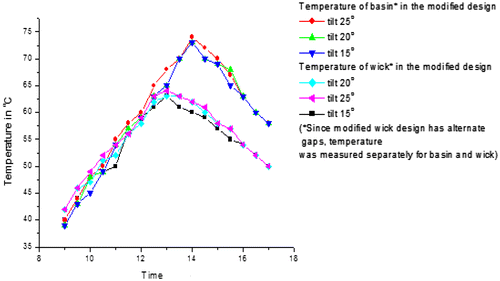
Figure 9. (a) Variation of distillate yield for different tilt angles (basin fully covered by wick) as a function of day hour and (b) Variation of distillate yield for different tilt angles (basin partially covered by wick) as a function of day hour.
Figure 9(a) and (b) shows the instantaneous distillate yield of the still with basin fully covered by wick and basin partially covered by wick for different tilt angles. The distillate yield was measured with a measuring jar at thirty minute intervals from 9.00 am to 6.00 pm. The total amount of daily productivity obtained by the basin fully covered by the wick with the tilt angle 15° was 2,900 ml/(m2-day) while the productivity of the still with basin partially covered was 3,324 ml/(m2-day). With 20° tilt and absorber fully covered by the wick, productivity increased to 3,239 ml/(m2-day) and 3,504 ml/(m2-day) in the case of still with basin partially covered. Finally, with 25° tilt and absorber partially covered by the wick, productivity increased to 3,640 ml/(m2-day) which was 275 ml/(m2-day) more than the still with basin fully covered for same tilt angle. Variation of total distillate output/day with respect to tilt angle is shown in Figure . Analysis of the distillate output shows that performance of the still increases with increase in tilt angle. More tilt causes the water to trickle over the bare basin which enhances evaporation. The increase in distillate yield of the proposed model is achieved with a simpler design than previous models (Ayoub et al., Citation2015; Mahdi et al., Citation2011; Refalo et al., Citation2016; Tanaka, Citation2013).
5. Conclusion
In this paper, the design, implementation, and performance evaluation of a “V”-type solar still with the effect of wick tilt and coverage in the climatic conditions of Coimbatore, India is presented. Tilted wicks with partial coverage increase the temperature of the evaporating surface and results indicate that the still has improved performance. Analysis of cover glass temperature shows that the glass temperature is independent of the tilt angle. However, a slight increase in wick temperature was recorded concerning increasing tilt angle. Distillate yield of the still with the basin fully covered by the wick was increased from 2,900 ml/(m2-day) to 3,365 ml/(m2-day) as the tilt angle increased from 15° to 25°. In the experiment, when the basin was partially covered by wick, the yield was 3,324 ml/(m2-day), 3,504 ml/(m2-day) and 3,640 ml/(m2-day) for the tilt angles 15°, 20° and 25° respectively. Since the partial coverage of the wick yielded higher output and would be lower cost, this is the superior arrangement.
Funding
The authors received no direct funding for this research.
Additional information
Notes on contributors
P.U. Suneesh
P.U. Suneesh is assistant professor in the Department of Science, M E S College of Engineering, Kuttippuram, Kerala affiliated with Kerala Technological University. He received his MSc degree in Physics from Calicut University, MPhil degree in Solid State Physics from Bharathidasn University, Trichy, Tamilnadu and PhD from Bharathiar University, Coimbatore, Tamilnadu. He has more than ten years experience of teaching Physics to undergraduate engineering students. His research interests include Renewable energy, Nano gas sensors and Desalination. His research work is associated with the Solar Energy Laboratory (Sri Ramakrishna Mission Vidhyalaya, College of Arts and Science, Coimbatore 641 020, India), Department of Physics (BR Ambedkar Bihar University, Muzaffarpur 842 001, Bihar, India) and Civil and Architectural Engineering, Tennessee State University, Tennessee, USA.
References
- Akash, B. A., Mohsen, M. S., Osta, O., & Elayan, Y. (1998). Experimental evaluation of a single-basin solar still using different absorbing materials. Renewable Energy, 14(1–4), 307–310.10.1016/S0960-1481(98)00082-2
- Alaian, W. M., Elnegiry, E. A., & Hamed, A. M. (2016). Experimental investigation on the performance of solar still augmented with pin-finned wick. Desalination, 379, 10–15.10.1016/j.desal.2015.10.010
- Aybar, H. Ş., Egelioğlu, F., & Atikol, U. (2005). An experimental study on an inclined solar water distillation system. Desalination, 180(1–3), 285–289.10.1016/j.desal.2005.01.009
- Ayoub, G. M., Al-Hindi, M., & Malaeb, L. (2015). A solar still desalination system with enhanced productivity. Desalination and Water Treatment, 53(12), 3179–3186. doi:10.1080/19443994.2014.933040
- Hansen, R. S., Narayanan, C. S., & Murugavel, K. K. (2015). Performance analysis on inclined solar still with different new wick materials and wire mesh. Desalination, 358, 1–8.10.1016/j.desal.2014.12.006
- Janarthanan, B., Chandrasekaran, J., & Kumar, S. (2006). Performance of floating cum tilted-wick type solar still with the effect of water flowing over the glass cover. Desalination, 190(1–3), 51–62.10.1016/j.desal.2005.08.005
- Kalidasa Murugavel, K. K., & Srithar, K. (2011). Performance study on basin type double slope solar still with different wick materials and minimum mass of water. Renewable Energy, 36(2), 612–620.10.1016/j.renene.2010.08.009
- Mahdi, J. T., Smith, B. E., & Sharif, A. O. (2011). An experimental wick-type solar still system: Design and construction. Desalination, 267(2), 233–238.10.1016/j.desal.2010.09.032
- Malaiyappan, P., & Elumalai, N. (2016). Productivity enhancement of a single basin and single slope solar still coupled with various basin materials. Desalination and Water Treatment, 57(13), 5700–5714.10.1080/19443994.2014.1003973
- Minasian, A. N., & Al-Karaghouli, A. A. (1995). An improved solar still: The wick-basin type. Energy Conversion and Management, 36(3), 213–217.10.1016/0196-8904(94)00053-3
- Omara, Z. M., Kabeel, A. E., Abdullah, A. S., & Essa, F. A. (2016). Experimental investigation of corrugated absorber solar still with wick and reflectors. Desalination, 381, 111–116.10.1016/j.desal.2015.12.001
- Refalo, P., Ghirlando, R., & Abela, S. (2016). The use of a solar chimney and condensers to enhance the productivity of a solar still. Desalination and Water Treatment, 57(48–49), 23024–23037. doi:10.1080/19443994.2015.1106096
- Srivastava, P. K., & Agrawal, S. K. (2013). Experimental and theoretical analysis of single sloped basin type solar still consisting of multiple low thermal inertia floating porous absorbers. Desalination, 311, 198–205.10.1016/j.desal.2012.11.035
- Suneesh, P. U., Paul, J., Jayaprakash, R., Kumar, S., & Denkenberger, D. (2016). Augmentation of distillate yield in “V”-type inclined wick solar still with cotton gauze cooling under regenerative effect. Cogent Engineering, 3(1), 1202476.
- Tanaka, H. (2013). Optimum inclination of still and bottom reflector for tilted wick solar still with flat plate bottom reflector. Desalination and Water Treatment, 51(34–36), 6482–6489. doi:10.1080/19443994.2013.792132

